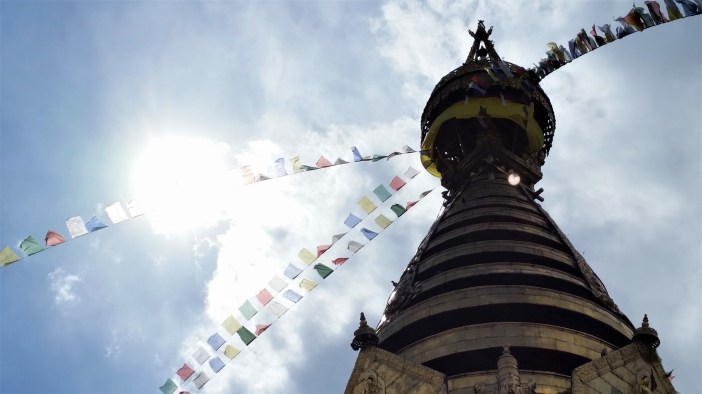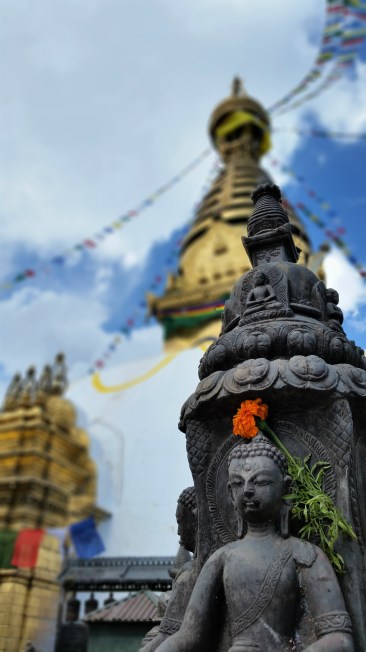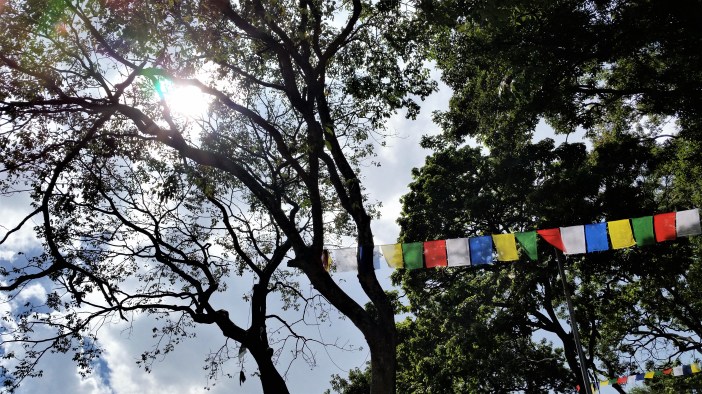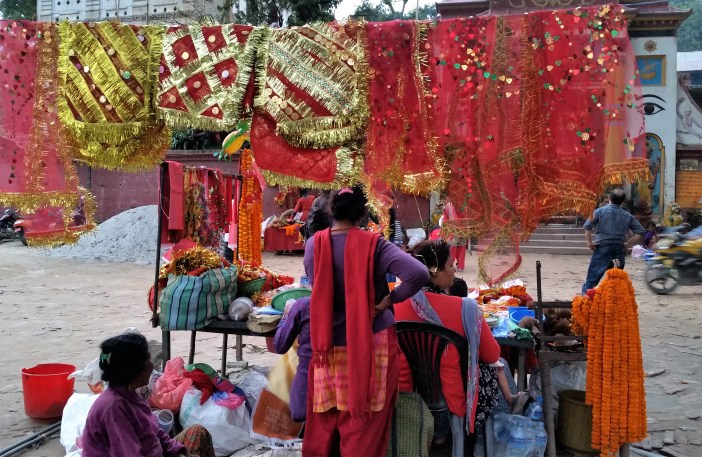
“What to do, Kathmandu?”
My guide smiled at me over our steaming bowls of vegetable soup. He’d shown me around Kathmandu’s famous Durbar Square and shrugged as if the question encompassed all we’d spoken about. His struggles to make ends meet. His conversion to Christianity. His attempts to be an honest guide in the midst of touts and scammers.
I smiled back and looked at the buildings around us. We were sitting in a rooftop café by the Square, looking at the intricately carved wooden structures and the remains of ancient buildings destroyed by the earthquake that shook the Kathmandu Valley in April 2015.

I wanted to know what Kathmandu would do. What anyone could do in the face of such odds.
How does a nation recover after disaster? How does a nation—and its visitors—overcome the economic disparities presented in a country like Nepal?

There I was, buying cappuccinos from rooftop cafes in a city where some families lived in houses with dirt floors, their buildings still crumbling post-earthquake. Watching other foreigners stocking up on hiking gear in the many shops in Thamel, the backpackers’ quarter, getting ready for their treks across mountains where they could hire local guides and porters for cheap and get their postcard-perfect photos for their Christmas cards. Stocking up on the stories they would tell, their tone slightly patronizing (even though they didn’t mean to be)—that time they went to the Himalayas. How nice the local people were. How they seemed so happy even though they had so little.
And yet, tourism is one of the biggest contributors to Nepal’s economy. Was it not in everyone’s best interest for me to hop on a tour and hire a porter and let the money flow out of my pockets?

*
When I’d read up on Nepal in various guidebooks and on travel websites, it had seemed like a traveler’s dream, with history lining the streets and nature calling from its borders.
But, to be honest, Nepal didn’t woo me as it has other tourists. Of course, this is neither Nepal’s fault nor its responsibility. At the same time, I didn’t do the things that most tourists (or voluntourists) do who sing Nepal’s praises.
I didn’t go trekking. I didn’t go paragliding in Pokhara like you’re supposed to. I didn’t even go to the 10-day silent retreat I’d applied for in Lumbini (the birthplace of Buddha!) because they were full.

But I also felt strange spending hundreds of dollars to go trekking or paragliding when I knew the vast majority of the population couldn’t do the same. What kind of world is that where much of a country struggles to get by while these (mostly white) tourists stream in dropping loads of cash on things that are “fun”?
To say I struggled is an understatement.

I also recognized that after a month of almost constant travel in India, I was beginning to hit a tourism wall.
I knew that if travel was to be my life for at least a year, I wouldn’t be able to be a tourist the whole time. That I would need to live in a different way. I needed to live.
And still, I was there to experience! To see new things! To dig into new cultures!
And I did.

I wandered the streets of Kathmandu, eyeing the intricate architecture of the buildings that had survived, hiking up to Swayambhunath Temple, looking down across the cloud of dust and smog that covered the city, smiling at the children flying kites for the holiday, families celebrating on the unfinished floors of their still-rebuilding houses.

But in the meantime, I felt myself falling into a kind of paralysis. Unable to reconcile myself with that space. Intending to write but struggling to do so. Fearing touts and scammers everywhere, especially after I’d gotten scammed twice in India and Nepal. Immobilized by my perfectionism, my wanting to get things right—cultural norms, language. Feeling instead like I was failing. Old feelings, old habits that even half a world away still haunted me.
And at night, I curled up in my hotel room and played Civ IV until I felt like I had control over something. Because out there was chaos. As was my life.
Shifting, unsteady, unwritten.
*
 There were bright spots in my Kathmandu life, of course. My tour guide in Durbar Square who was kind and friendly and seemed genuinely happy to meet another Christian and who told me how his faith helped rescue him from despair. Who invited me to come to church with him if I was still in Kathmandu for a weekend service.
There were bright spots in my Kathmandu life, of course. My tour guide in Durbar Square who was kind and friendly and seemed genuinely happy to meet another Christian and who told me how his faith helped rescue him from despair. Who invited me to come to church with him if I was still in Kathmandu for a weekend service.
The owners of the hotel where I stayed in Thamel (the backpacker quarter in Kathmandu) who shared with me their experience in the earthquake and how, for a long time, after weeks of living outside in tents in safe, open areas, they couldn’t go to the top floor of their hotel because they were too traumatized. And who later shared vodka and snacks with me and a few other guests in the lobby to celebrate Dashain, the nation’s biggest holiday. Their kind greetings as I came and went and their son teaching his little brother the English alphabet in the lobby in the mornings.

Getting my fortune read by Pashupatinath Temple, one of the oldest and most important Hindu temples in Kathmandu. The fortuneteller tying a bundle of red threads around my wrist—threads still there, months later—blessing me with the words “God have mercy” in both Nepali and English. (By the way, I’m going to live until I’m 81 and have already met the person I’m going to marry and am going to be very successful in the marketing profession.)

Having a delicious vegetarian dinner with a new feminist friend, drinking a “Hurricane” at a place called New Orleans Café, and talking late into the night about everything from Irish politics (her home) and American politics to reproductive rights to the queer scene in Nepal. Talking until we shut the place down.
But Kathmandu was hard, too. People seemed friendlier on the face of things than I experienced in India—in small things, like smiling and greeting me when I went to a restaurant. Still, I couldn’t help but feel an undercurrent of something else.
“This place was burning for days after the earthquake,” another guide I met said of the pyres for cremation that lined the river by Pashupatinath Temple. We saw a cremation while I was there—a somber, quiet moment, the smoke rising, the last remains of the bones and ash being pushed into the dark water. “Thousands of people were cremated here.”
Did that cloud still hang over the city? Or was it a cloud I brought with me—one of guilt at having the privilege to sell all my things and travel?
The privilege that selling my things added up to enough to buy me even a plane ticket?

In the midst of that, I found my way to gardens and temples and other spaces that I knew would help center me. Still, I knew I couldn’t stay, but I didn’t know where to go.
What my body and heart were calling me to do was to stop and listen. To be still after learning so much about stillness. About destruction and rebirth. About the blessing of a single moment.
*
I stayed for a week in Kathmandu, preparing to make my way toward Lumbini, where I’d registered for that silent retreat. But when they e-mailed to say that there was no space for me, I made a plan B. With my hotel owner’s help, I booked a bus ticket to Pokhara, a quiet lakeside city toward the central-west of the country nestled at the foot of the Himalayan Mountains. And I booked an Airbnb that promised to give me two weeks’ worth of the quiet I so longed for.
The morning I left Kathmandu, I ate the hotel’s delicious homemade breakfast and sweet, hot chai. And I scrambled after my host as he led me to the place where the bus would pick me up.
The dust kicked up into the sky as cars and motorbikes drove past, their engines roaring around me and honking coming from all sides. We waited. A big green bus pulled over. I threw my pack in the back.
The kind eyes of the hotel owner looked after me as the bus trundled on to Pokhara.

Travel Tips
- Tours and Guides
- Only take tours in Kathmandu from certified guides. They should have some kind of card showing their credentials, and their are plenty of non-credentialed folks who are ready to give you “behind-the-scenes” tours for “free” (but then will make an ask at the end, or worse (as they did with me), ask you to buy hundreds of dollars worth of groceries). More on that later, but in the meantime, a couple recommendations for tours and guides:
- Tour Companies: There are a number of local and international companies offering tours of Kathmandu and beyond. I had a pretty good tour with Urban Adventures, which offers a range of tours of the city. Social Tours also comes highly recommended.
- Local Guides: If you go to Durbar Square, you’ll likely get approached by local tour guides for an individually guided tour. I have mixed feelings about getting guides for local spots like this, but really, they can give you a lot more context and connection to the local culture in a way you can’t get just looking at old buildings or using your Lonely Planet guide. I paid 1000 rupees (about $10USD) for a local guide to show me around for a couple hours and ended up with a nice conversation and heaps of kindness on top of the tour. My guide was Bishwo Shahi, and you can message him on Facebook to arrange half-day and day-long tours of local sights. He’s quite kind and knowledgeable, so if you get the chance, give him a shout.
- Only take tours in Kathmandu from certified guides. They should have some kind of card showing their credentials, and their are plenty of non-credentialed folks who are ready to give you “behind-the-scenes” tours for “free” (but then will make an ask at the end, or worse (as they did with me), ask you to buy hundreds of dollars worth of groceries). More on that later, but in the meantime, a couple recommendations for tours and guides:
- Accommodations
- I stayed in a couple hotels in Kathmandu, but my favorite was Hotel Bright Star in Thamel (the backpackers’ quarter of the city). The hotel is small and family-run, and the family is super nice and hospitable. I really felt at home there, and it was lovely to have smiling faces greet me after a day out in Kathmandu’s bustle. Plus, you can also select to get breakfast included in your stay, and the owner’s breakfast offerings are delicious and plentiful (if pretty standard). Plus, at about $10USD per night for a private room with en suite bathroom, you won’t break the bank either.
- My second favorite hotel was the (somewhat spartan) Boudha Inn and Meditation Centre in Boudhha (a kind of suburb to Kathmandu). It was a much different vibe from Thamel, with a mix of backpackers and monks and Buddhist pilgrims filling the nearby streets. You’ll also have your pick of nearby Tibetan eateries and quiet cafes just doors down from the hotel. As an added bonus, the hotel has a meditation room and offers yoga and meditation classes. Not a bad deal!
- Restaurants and Cafes
- Restaurants: There are lots of great restaurants in the Thamel area in particular, ranging from Korean to Indian to Thai to fancy Italian.
- OR2K: My favorite restaurant was OR2K, an Israeli-owned business that offers a range of foods but seems to specialize Asian fusion. However, my favorite meals involved anything they made with cheese (but maybe I was just craving cheese). Chill atmosphere, decent (if tourist) prices, and a wide range of vegetarian and vegan options. They also have a branch in Pokhara.
- Gaia Restaurant: I really wanted to try their Eggs Benedict but got up too late for their brunch/breakfast foods. Seemed to keep pretty busy, and with good reason–their food is delicious (though, again, catering to a more Western palate). Their atmosphere is even better, with a lovely patio and outside seating that’s perfect for a fall afternoon.
- Hankook Sarang: Okay, so I was clearly looking for comfort food by this point, and because of the time I’ve spent in Korea, Korean is one of those foods. I had their bibimbap (big rice bowl with veggies and meat (optional) that you mix all together), and it was delicious. So if you’re feeling some Asian food and Korean fits the bill, head here! As an added bonus, prices tend to run a little cheaper than the Western restaurants (about $3-6 per meal).
- Cafes and Coffeeshops: I tried to use much of my downtime in Kathmandu to catch up on my life after being on the go so much in India. While I got a lot of writing done, Wi-Fi in Nepal is hit-or-miss (and mostly miss). So if you work remotely as you travel, I’d recommend getting a SIM card and/or bringing your own hotspot (if possible). In the meantime, I did find a couple cafes where I got some work done.
- Revolution Cafe: Revolution Cafe seemed to have the most reliable internet that I had perhaps the entire month I was in Nepal. Maybe I was just lucky on my two visits there, or maybe they’re just great. Regardless, their food is amazing and seems to run along the Asian fusion or East-meets-West line. They also offer a range of coffees, teas, and desserts, all at pretty reasonable prices. I spent hours here, and I can only say good things about them.
- Himalayan Java: Himalayan Java is a Nepali chain that offers good coffee and light meals. I spent a lot of time at Himalayan Javas in various parts of the country, but as with most of the places where I tried to find the Internet, the Wi-Fi only worked about half of the time. But when it did, it was pretty good! Their coffee drinks aren’t bad, either, but are a little pricey (about $4-5USD per drink).
- Chikusa Cafe: Chikusa Cafe (in Thamel) came recommended to me by a fellow traveler who joyfully discovered its brewed coffee after weeks of drinking Nescafe while trekking. It’s a small place with a diner vibe and really great prices (for example, a mug of brewed coffee runs you 130 rupees or about $1.30USD). They don’t have Wi-Fi, from what I recall, but it would be the perfect place to read a book or get some writing done in a down-to-earth atmosphere.
- Restaurants: There are lots of great restaurants in the Thamel area in particular, ranging from Korean to Indian to Thai to fancy Italian.
- Getting Around
- Taxis: A lot of the sites in Kathmandu are walkable, but for longer journeys, hail a cab and get ready to negotiate. Especially if you’re a westerner, you’ll get “foreign prices” at first–try to negotiate down as much as you can and have an idea what costs typically are (check out Lonely Planet and other such guides for tips and/or ask at your hotel). Note that if you’re traveling after dark or at rush hour, prices tend to go up!
- Buses: Local and inter-city buses can get you to a lot of places you might travel to, but you might need help navigating them. Don’t be afraid to ask for guidance from your hotel staff–mine were a wealth of knowledge (especially at Hotel Bright Star). I took an air-conditioned bus from Kathmandu to Bhaktapur and back for cheap (a few dollars). Find out more about getting to Bhaktapur and elsewhere on The Longest Way Home, a great source for Nepal tourism information.
- Additional Tips
- Need green space? Kathmandu can be a little overwhelming even for the most seasoned traveler. If you’re looking for some quiet, green space to center yourself, try visiting the Garden of Dreams at the edge of Thamel. It’s like a beautiful oasis in the midst of the city’s bustle, and the entry fee is only a 200-300 rupees (about $2-3USD).
- Want to do some more serious centering? I visited a great yoga studio while hanging out in Kathmandu. Check out Pranamaya Yoga if you want to get some yoga in while you travel. Good instructor (instruction in English), nice space, and close to Thamel. Cost of a drop-in class is 700 rupees (around $6-7USD).
- Want to learn more? I consulted The Longest Way Home a number of times while planning my trip to Nepal and found it to be a fantastic resource for on-the-ground knowledge about traveling through the country. Check them out!



There are a lot of really helpful tips in this post, especially about tours. Thanks a lot for sharing!
LikeLike
Glad it’s helpful! I really wished I’d taken one of the arts or cooking classes/tours before I left 🙂 Maybe next time!
If you head that way, let me know if you need any more ideas/etc. I’ll be writing about Pokhara soon, which I can recommend 110%. (But I think I was also just in a lake and mountain mood then, too.)
LikeLiked by 1 person
Hi,
This post is in response to your article “THIS WAS MY EXPERIENCE AS A GENDERQUEER TRAVELER IN INDIA”
I can understand your frustrations of being misgendered. As a non-binary queer person, it frustrates me to no end when people assume my gender rather than ask respectfully. However, I would also suggest that you spend a greater amount of time reflecting on other parts of your identity such as your white/European ancestry line, and the historical context in which these countries have colonized more than half the world in exploitation and oppression of these countries who appear to be seemingly “behind” in understanding gender. Which in actuality is a false assumption, if you spend more time researching about their deities such as Shiva who carried both masculine and feminine energies.
I would ask that you take a much more critical approach to reflect on your own positions within the larger context, and examine reasons why you wish to travel to countries that have historically been colonized, exploited, and oppressed by white Europeans and address the issue of a white person entering into these countries i know gender issues is a problem in a lot of places, but let’s try to put that aside for just one second and recognize white privilege. some of these people in places you visit will never have the opportunity to step on an airplane.
LikeLike
Hi, AcidAcid, and thank you so much for taking the time to respond and for calling me out on my privilege and failure to provide context. You are absolutely right, and I’m sorry I didn’t do that important work better. And I’ll work harder to to so in each article I write.
I’ve tried to do more of what you (rightfully) ask throughout my blog (for instance, my article on white privilege while traveling (https://youarequeerhere.com/2016/10/18/white-people-problems-american-tourist-edition/)), and I think when I originally wrote this post for my blog, I viewed it in the context of people who were regularly reading it (and would have some of that context covered in other posts). So I should’ve done a better job reconsidering that when Matador said they could publish it, and I should have asked to make some edits to contextualize my positionality better. It was my oversight/fault for not doing so! (And I can stand to do a better job providing that in my articles in generally, knowing that not everyone who reads them will have read prior pieces).
To clarify what I do believe: You’re 100% right. India isn’t “behind” in any way, and I’m sorry if my article seemed to support that opinion. I’ve had “gender problems” in almost every country I’ve traveled to, as non-binary folks are likely to experience, and my non-binary/trans friends in the U.S. have probably experienced more misgendering. So it definitely doesn’t just fall on India, and you’re right, too, that India has long been more progressive in both issues of gender/sexuality (and that it was colonial laws put in place by the British that outlawed homosexual acts). You’re so right that white privilege (and for me specifically, white American middle-class privilege) needs to be addressed more and better. And I pledge to work to do so.
So, thanks again for taking the time to share this and for challenging me to do this hard and important work and to do it better.
LikeLike
AcidAcid, I also wanted to make sure that your concerns and my promise to do better about this weren’t buried here in the comments on a solitary blog post, so I wrote a post on Facebook to thank you, apologize, acknowledge the things you mentioned (including my privilege), and promise to do better. Thanks again for calling me out. Even activists like me (perhaps especially us) need it from time to time, so I appreciate it. It’s not enough, but I hope it’s a start and at least puts me out there to continue to be held accountable for my positionality: https://www.facebook.com/youarequeerhere/posts/1216194728487396
LikeLike